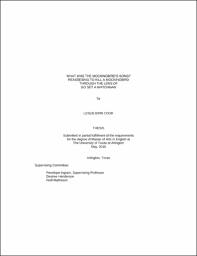
ATTENTION: The works hosted here are being migrated to a new repository that will consolidate resources, improve discoverability, and better show UTA's research impact on the global community. We will update authors as the migration progresses. Please see MavMatrix for more information.
Show simple item record
| dc.contributor.advisor | Ingram, Penelope | |
| dc.creator | Cook, Leslie Erin | |
| dc.date.accessioned | 2018-02-01T15:34:50Z | |
| dc.date.available | 2018-02-01T15:34:50Z | |
| dc.date.created | 2016-05 | |
| dc.date.issued | 2016-05-11 | |
| dc.date.submitted | May 2016 | |
| dc.identifier.uri | http://hdl.handle.net/10106/27136 | |
| dc.description.abstract | The publication of Go Set a Watchman, a companion piece to Harper Lee’s To Kill a Mockingbird, problematizes many of the accepted readings of the canonical text. This ‘new’ novel is actually the initial manuscript of the ‘old’ classic Harper Lee submitted to her publisher in 1957. In this iteration, readers find 26-year-old Jean Louise and 72-year-old Atticus at odds over the Brown v. Board of Education decision. The father does not believe that the Supreme Court has the right to legislate integration for the individual states, and works to keep NAACP lawyers out of Maycomb. His daughter is shocked and appalled by her father’s choices, believing them to be in contradiction to the egalitarian philosophy in which Atticus has raised her. Jean Louise is thus forced to differentiate herself from her father and come to her own conclusions – in the process learning that the self-awareness and autonomy necessary to do so were in fact her father’s most valuable bequests to her.
So then, Scout was first envisioned as a young woman on the cusp of the Civil Rights’ Movement, struggling to break free from the more backward aspects of her Southern heritage, and Atticus was a respected patriarch who had fulfilled his purpose in enabling his child to grow and evolve beyond him.
This thesis will argue that the existence of Go Set a Watchman demands a reanalysis of To Kill a Mockingbird. It will assert that, although a great deal about the plot and details of the story changed in the revisions and re-writings that would take Harper Lee from Watchman to Mockingbird, the essence of her characters did not. The Atticus we encounter in Mockingbird remains an imperfect man, shaped by his environment, and incapable of saving his beloved Maycomb from its darker proclivities or from the frighteningly different future toward which it is hurtling. Atticus Finch saves no one in Mockingbird because he is no more capable of it in 1935 than he was in 1957.
It is Scout’s ability to change and grow which offers hope for the future of the South and will take the next generation into a better world, not the hero worship of a clearly flawed Atticus which has become the focus of most scholarship on Mockingbird. With this in mind, it is necessary to consider some of the major changes that take place between drafts of the Finch family’s story and determine why they might have changed and how they serve to further the uniting theme of Scout’s autonomy. In sum, the changes serve mostly to accentuate Atticus’s failure as the hero, while at the same time highlighting his success as a father empowering his child to grow beyond him, thus re-centering Scout in the narrative. | |
| dc.format.mimetype | application/pdf | |
| dc.subject | Harper Lee | |
| dc.subject | To Kill a Mockingbird | |
| dc.subject | Go Set a Watchman | |
| dc.subject | Atticus Finch | |
| dc.subject | Horton Foote | |
| dc.subject | Scout Finch | |
| dc.title | WHAT WAS THE MOCKINGBIRD’S SONG? REASSESING TO KILL A MOCKINGBIRD THROUGH THE LENS OF GO SET A WATCHMAN | |
| dc.type | Thesis | |
| dc.degree.department | English | |
| dc.degree.name | Master of Arts in English | |
| dc.date.updated | 2018-02-01T15:36:57Z | |
| thesis.degree.department | English | |
| thesis.degree.grantor | The University of Texas at Arlington | |
| thesis.degree.level | Masters | |
| thesis.degree.name | Master of Arts in English | |
| dc.type.material | text | |
| dc.creator.orcid | 0000-0002-7759-2126 | |
| local.embargo.terms | 2018-05-01 | |
| local.embargo.lift | 2018-05-01 | |
Files in this item
- Name:
- COOK-THESIS-2016.pdf
- Size:
- 490.4Kb
- Format:
- PDF
This item appears in the following Collection(s)
Show simple item record


